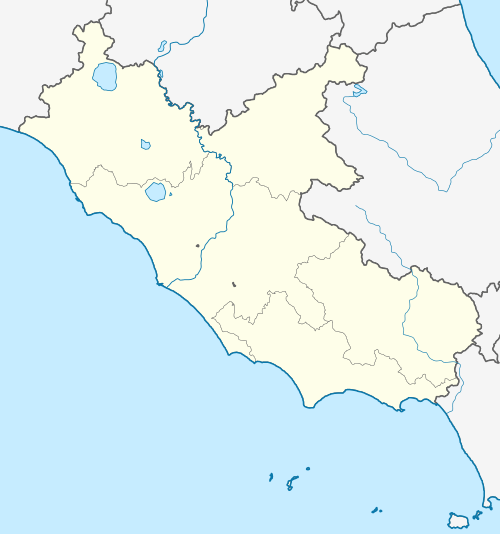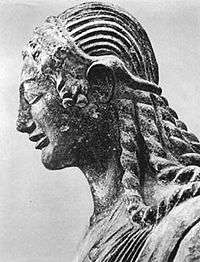Pyrgi
|
the Pyrgi plaques | |
 Shown within Lazio | |
| Location | comune di Santa Severa |
|---|---|
| Region | Lazio, Italy |
| Type | settlement, port |
| History | |
| Cultures | Etruscan Roman Republic |
| Site notes | |
| Excavation dates | yes |
| Archaeologists | Giovanni Colonna; Mario Torelli |
| Condition | ruined |
| Public access | no |
Pyrgi was an ancient Etruscan port in Latium, central Italy, to the north-west of Caere. Its location is now occupied by the borough of Santa Severa.
Remains of its defensive walls exist in polygonal blocks of limestone and sandstone, neatly jointed. They enclosed a rectangular area some 200 m in width and at least 220 m in length. The south-west extremity has probably been destroyed by the sea. It contained a rich temple of Leucothea, the foundation of which was ascribed to the Pelasgi. It was plundered by Dionysius in 384 BC. Later it became dependent on Caere, though it is not probable that it was originally merely the harbour of Caere; Alsium was c. 8 km (5 mi) to the south.[1]

The Romans established a colony here, which is first mentioned in 191 BC. Later still it supplied fish to Rome, and became a favorite summer resort, as did also Punicum (Santa Marinella), 8 km (5 mi) to the north-west, where are many remains of villas. Both were stations on the coast road (Via Aurelia).[1]
In 1957 excavations found the remains of a large temple with a triple-cella arrangement.[2] The Pyrgi Tablets, containing texts in Phoenician and Etruscan languages, were found here in 1964.[3][4]
References
- 1 2 Ashby 1911, p. 689.
- ↑ Luisa Banti (1973). Etruscan Cities and Their Culture. University of California Press. pp. 51–. ISBN 978-0-520-01910-2.
- ↑ Schmitz, Philip C. 'The Phoenician Text from the Etruscan Sanctuary at Pyrgi' in Journal of the American Oriental Society , Vol. 115, No. 4 (Oct. - Dec., 1995), pp. 559-575.
- ↑ Jean MacIntosh Turfa (16 July 2012). Divining the Etruscan World: The Brontoscopic Calendarand Religious Practice. Cambridge University Press. pp. 24–. ISBN 978-1-107-00907-3.
- Attribution
![]() This article incorporates text from a publication now in the public domain: Ashby, Thomas (1911). "Pyrgi". In Chisholm, Hugh. Encyclopædia Britannica. 22 (11th ed.). Cambridge University Press. p. 689.
This article incorporates text from a publication now in the public domain: Ashby, Thomas (1911). "Pyrgi". In Chisholm, Hugh. Encyclopædia Britannica. 22 (11th ed.). Cambridge University Press. p. 689.
External links
Coordinates: 42°00′54.81″N 11°57′48.29″E / 42.0152250°N 11.9634139°E
